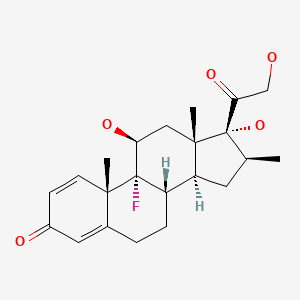CASRN: 378-44-9

Drug Levels and Effects
Summary of Use during Lactation
Since only extensive application of the most potent corticosteroids may cause systemic effects in the mother, it is unlikely that short-term application of topical corticosteroids would pose a risk to the breastfed infant by passage into breastmilk. However, it would be prudent to use the least potent drug on the smallest area of skin possible. It is particularly important to ensure that the infant's skin does not come into direct contact with the areas of skin that have been treated. Only the lower potency corticosteroids should be used on the nipple or areola where the infant could directly ingest the drugs from the skin; topical betamethasone should be avoided on the nipple.[1] Betamethasone ointment appears to have no advantage over lanolin for treating sore nipples during breastfeeding.[2] Current guidelines allow topical corticosteroids to be applied to the nipples just after nursing for eczema, with the nipples cleaned gently before nursing.[3,4] Only water-miscible cream or gel products should be applied to the breast or nipple because ointments may expose the infant to high levels of mineral paraffins via licking.[5]
Drug Levels
Maternal Levels. Relevant published information was not found as of the revision date.
Infant Levels. Relevant published information was not found as of the revision date.
Effects in Breastfed Infants
Topical application of a corticosteroid with relatively high mineralocorticoid activity (isofluprednone acetate) to the mother's nipples resulted in prolonged QT interval, cushingoid appearance, severe hypertension, decreased growth and electrolyte abnormalities in her 2-month-old breastfed infant. The mother had used the cream since birth for painful nipples.[6]
A woman who was nursing (extent not stated) her newborn infant was treated for pemphigus with oral prednisolone 25 mg daily, with the dosage increased over 2 weeks to 60 mg daily. She was also taking cetirizine 10 mg daily and topical betamethasone 0.1% twice daily to the lesions. Because of a poor response, the betamethasone was changed to clobetasol propionate ointment 0.05%. She continued breastfeeding throughout treatment and her infant was developing normally at 8 weeks of age and beyond.[7]
Effects on Lactation and Breastmilk
In a randomized, double-bind trial, lanolin was compared to an all-purpose nipple ointment containing betamethasone 0.05%, mupirocin 1%, and miconazole 2% for painful nipples while nursing in the first 2 weeks postpartum. The two treatments were equally effective in reducing nipple pain, nipple healing time, breastfeeding duration, breastfeeding exclusivity rate, mastitis and nipple symptoms, side effects or maternal satisfaction with treatment.[1]
Alternate Drugs to Consider
(Topical) Hydrocortisone, Topical, Triamcinolone, Topical
References
- 1.
- Barrett ME, Heller MM, Fullerton Stone, H, Murase JE. Dermatoses of the breast in lactation. Dermatol Ther 2013;26:331-6. [PubMed: 23914890]
- 2.
- Dennis CL, Schottle N, Hodnett E, McQueen K. An all-purpose nipple ointment versus lanolin in treating painful damaged nipples in breastfeeding women: A randomized controlled trial. Breastfeed Med 2012;7:473-9. [PubMed: 22428572]
- 3.
- Vestergaard C, Wollenberg A, Barbarot S, et al. European task force on atopic dermatitis position paper: treatment of parental atopic dermatitis during preconception, pregnancy and lactation period. J Eur Acad Dermatol Venereol 2019;33:1644-59. [PubMed: 31231864]
- 4.
- Deleuran M, Dézfoulian B, Elberling J, et al. Systemic anti-inflammatory treatment of atopic dermatitis during conception, pregnancy and breastfeeding: Interdisciplinary expert consensus in Northern Europe. J Eur Acad Dermatol Venereol 2024;38:31-41. [PubMed: 37818828]
- 5.
- Noti A, Grob K, Biedermann M, et al. Exposure of babies to C(15)-C(45) mineral paraffins from human milk and breast salves. Regul Toxicol Pharmacol 2003;38:317-25. [PubMed: 14623482]
- 6.
- De Stefano P, Bongo IG, Borgna-Pignatti C, Severi F. Factitious hypertension with mineralocorticoid excess in an infant. Helv Paediatr Acta 1983;38:185-9. [PubMed: 6874387]
- 7.
- Westermann L, Hugel R, Meier M, et al. Glucocorticosteroid-resistant pemphigoid gestationis: Successful treatment with adjuvant immunoadsorption. J Dermatol 2012;39:168-71. [PubMed: 22379622]
Substance Identification
Substance Name
Betamethasone, Topical
CAS Registry Number
378-44-9
Drug Class
Breast Feeding
Lactation
Milk, Human
Corticosteroids, Topical
Glucocorticoids
Anti-Inflammatory Agents
Disclaimer: Information presented in this database is not meant as a substitute for professional judgment. You should consult your healthcare provider for breastfeeding advice related to your particular situation. The U.S. government does not warrant or assume any liability or responsibility for the accuracy or completeness of the information on this Site.
Publication Details
Publication History
Last Revision: January 15, 2024.
Copyright
Attribution Statement: LactMed is a registered trademark of the U.S. Department of Health and Human Services.
Publisher
National Institute of Child Health and Human Development, Bethesda (MD)
NLM Citation
Drugs and Lactation Database (LactMed®) [Internet]. Bethesda (MD): National Institute of Child Health and Human Development; 2006-. Betamethasone, Topical. [Updated 2024 Jan 15].